The U.S. Attorney's hidden role in undermining DC's gun laws
Damning new evidence about thousands of gun cases
Last week the DC Sentencing Commission released their Annual Report, which is one of our only data sources for what happens to cases after police make an arrest. Without this data we would never know that 79% of adults arrested with illegal guns in DC get away without any felony conviction. More than 2,000 gun cases over the last two years were either never prosecuted, dropped or pled down to lesser charges without any public scrutiny of DC’s prosecutor. This report (and similar excellent analyses by the Commission’s staff) are crucial for understanding how prosecutors and judges apply the laws on the books and getting beyond the vibes-based spin that dominates DC crime discourse. The report especially highlights the gap between how the United States Attorney’s Office (USAO) acts in court vs. their poll-tested “tough on crime” public rhetoric. With kids as young as 3 years old being killed in shootings, we desperately need some accountability for our unelected prosecutor who has undermined all of DC’s local efforts to reduce gun violence.
The DC Sentencing Commission Annual Report is 71 pages long (plus appendices) and represents an enormous amount of work by the commission’s staff. This blog has cited their prior work in numerous posts and they deserve a lot of credit for their efforts to educate the public and “demystify the criminal justice system for the broader community.” The commission only has data for adult arrests, prosecutions and sentencing so unfortunately we don’t have similar transparency into juvenile prosecutions by the Office of the Attorney General (OAG). However, since the vast majority (90%) of homicide suspects are adults this dataset is incredibly comprehensive for understanding DC’s gun violence problem. Here are the key points about prosecutions and sentencing overall before we dive into some of the specific problems with how the USAO handles gun cases:
Prosecutors pressed charges in or “papered” 66% of adult felony arrests in 2023; “a 12% increase from the papering rate observed in 2022, and the first increase in papering rates observed between 2018 and 2023”
2023 is the year that the USAO finally came under public pressure to increase prosecution rates after years of decline and the data confirms that the pressure worked
Despite the increase in new prosecutions, felony convictions actually fell with “a 3% reduction in counts and approximately a 12% reduction in both cases and individuals sentenced.”
“Ninety-two percent (92%) of felony cases in 2023 were resolved through a plea agreement” which means that the prosecutors agreed to the (often reduced) charges being sentenced
“98.6% of all felony counts sentenced were Compliant” with the voluntary sentencing guidelines put forth by the commission. The guidelines process is very important because judges overwhelmingly follow them.
Anecdotally DC judges tend to impose sentences on the lower end of what is allowed by the sentencing guidelines but they rarely go outside of the guidelines. In most of the cases where a suspect gets a “scandalously light sentence” it’s because their plea bargain actually convicts them of a lesser offense where lighter sentences are allowed under the sentencing guidelines.
In 2023 “Superior Court Judges increased the percentage of prison sentences imposed for non-Drug felony offenses. Approximately 70% of felony counts received a prison sentence.”
When prosecutors secure a non-Drug felony conviction the vast majority of defendants are sentenced to a prison term; which is what the USAO claims they want in order to “incapacitate” offenders from committing more crimes. But because so many cases that begin as arrests for felony conduct are dropped or pled down to non-felony offenses by the USAO fewer cases actually get these prison sentences.
While United States Attorney (USA) Matthew Graves likes to brag to the media that his office won convictions with “thousands of years” of prison sentences, in 2023 they actually secured 36% fewer felony counts than the 2014-2018 average. Even more concerning, this drop in felony convictions occurred when the courts were working through the COVID-era case backlog; which if anything would artificially boost the volume of convictions:
The decrease in felony convictions (relative to pre-COVID) is true across all categories with a particular collapse in felony drug offenses. This has been great news for DC’s gangs/crews who are responsible for a significant share of DC’s gun violence and “are heavily engaged in narcotics sales.” The crime lab’s loss of accreditation and the failure of the Bowser Administration and the USAO to secure sufficient outside evidence testing capacity undermined drug prosecutions for years. This has taken away a key lever to “incapacitate” DC’s violent gangs/crews:
One factor reducing the impact of the USAO’s violent crime convictions is that a huge share of the convictions are for plea bargained down to the lesser “Attempted” versions of these offenses that carry shorter sentences. Also, for all of the “discourse” about DC’s carjacking statutes there “were only seven adult carjacking counts sentenced in 2023.” The VAST majority of adult carjacking cases are pled down to some lesser offense like unarmed robbery, despite 77% of carjackings involving guns in 2023:
While the decrease in “Weapon, Property, Other” felony convictions was relatively small this is entirely because the Metropolitan Police Department (MPD) has dramatically ramped up gun possession arrests as illegal guns have flooded into DC. The USAO has undermined this MPD effort by securing 39% fewer felony convictions per gun possession arrest because they are declining, dropping or pleading down more cases than just a few years ago:
In 2023 the prosecution “filter” for gun possession cases looked like this:
The USAO outright declined to prosecute 33% of arrests for felony gun possession
37% of the initially-charged cased were later dropped without a conviction
50% of the convictions the USAO did win were for misdemeanors only; up from 41% in 2022 and just 29% in 2018. Again, since 92% of cases are resolved by plea bargains, reducing the charges from a felony to a misdemeanor is very much an outcome the USAO is signing off on; not one “imposed” by DC judges.
Cumulatively this “filter” means that only 21% of adults arrested with an illegal gun in DC end up with a felony conviction.
While every prosecutor has some kind of filter like this (i.e. no one charges and wins every case), in DC it has gotten much worse at the stages where the USAO has the greatest level of discretion but less transparency: the initial charging stage and at plea bargaining. Looking specifically at cases for Carrying a Pistol Without a License (CPWL), which are 75% of the arrests for gun possession, we see the USAO is securing less than half as many felony convictions per arrest as they did in 2018:
In 2018 the USAO prosecuted 85% of CPWL cases while in 2023 they only charged 68%. This was at least up from a record-low 53% prosecution rate in 2022.
While the USAO has claimed that adverse rulings by the DC Court of Appeals are the reason they can’t prosecute many gun cases, the fact that they were able to increase their CPWL prosecution rate by 15% in a single year without overturning those rulings suggests those rulings were more of a convenient excuse. It’s also telling that the USAO has so far not tried to appeal those rulings that they say are out of step with Supreme Court precedent.
In 2023 the USAO secured a conviction in 64% of resolved cases, just 4% higher than the 60% conviction rate in 2018. The USAO declining a huge share of cases up front has barely increased their conviction rate, despite the USAO’s spin that they are primarily declining to prosecute non-viable cases.
In 2018 71% of CPWL convictions were for the actual felony charge but in 2023 this fell to only 40%. 60% of the 2023 convictions were for lesser misdemeanor charges (again, almost entirely due to plea bargains offered by the USAO). This is strong evidence that the USAO has become much more willing to offer and accept misdemeanor-only plea bargains for felony gun possession.
Defense lawyers call a misdemeanor plea bargain for CPWL a “golden ticket” because they are so generous but are now 60% of the USAO’s convictions. Under USA Graves, the USAO has doled out these “golden tickets” to gun suspects at unprecedented levels.
Here’s an example of the kind of case that the USAO calls a “win” because it ended in a conviction but only results in an “Attempted” CPWL sentence with no jail time. In the screenshot from court records below note that the 120 days of “confinement” is “suspended” and the “Amount To Serve” is 0 days:
Here’s a case where MPD caught the suspect with a “Glock converter” or “giggle switch” that transforms a semi-automatic pistol into a fully-automatic machine gun. The USAO offered a “golden ticket” plea bargain that reduced the charges to misdemeanor “Attempted” CPWL so as a result this defendant was only sentenced to 60 days in jail:
The cases where individuals get misdemeanors for carrying de facto machine guns (often pistols with a ”conversion switch” that makes it fully automatic) are especially egregious because the USAO could simply prosecute these individuals under Federal firearms laws in District Court (as opposed to charging them under local DC laws in DC Superior Court). The already-existing Federal laws against machine guns (which apply to “conversion switches”) carry severe penalties (up to 10 years for mere possession) and gun cases tend to be more successful in District Court. The USAO could choose at any time to announce that anyone caught with these machine guns will be prosecuted in District Court and highlight the severe penalties that entails. This would be the kind of “sending a message” that might actually have a deterrent effect on criminals; unlike some of DC’s other more performative efforts to “send a message” about crime. The fact that every day the USAO chooses NOT to do this is a sign that they are “rationing” District Court slots for their their other priorities. One should read Chief Smith’s testimony saying “One factor driving the higher lethality of shootings is the increase in the use of conversion switches” as well as listen to the audio from the fully automatic shootout near Dunbar High School and consider that the USAO thinks carrying that kind of weapon is mere misdemeanor conduct.
If we compare the USAO’s gun possession prosecution outcomes to the Manhattan District Attorney (DA) we see that the USAO both declines to prosecute a much higher share of cases AND is more willing to let suspects plead down to misdemeanors. Notably the Manhattan data looks very similar to the DC data from 2018 before the USAO’s performance eroded:
Every time I post a comparison to the Manhattan or Philadelphia prosecutors, conservatives contact me to point out that they regard those District Attorneys as still hopelessly “weak on crime.” Whatever one thinks of those “progressive” prosecutors, DC’s unelected Federal prosecutor is much more lenient towards people carrying illegal guns.
There are also clear disparities in how the USAO treats illegal gun possession in different parts of DC. In 2023 the highest prosecution rates (73%-75%) were in DC’s wealthiest neighborhoods in wards 2 and 3. However in much poorer Ward 7 the USAO only prosecuted 59% of gun cases. There isn’t a perfect correlation between wealth and prosecution rates however as Ward 8 had a 70% prosecution rate, though that still represents over 100 people arrested with illegal guns and not prosecuted at all:
Gun violence is the single most important crime problem in DC today. Guns were used in 84% of DC’s homicides through April 30th and the fear of shootings is a constant toll on thousands of Washingtonians. While homicides are down 22% YTD (through May 3rd), high-profile and terrifying shootings like the fully-automatic shootout by Dunbar High School that grazed a student’s head (and easily could have killed her) are unacceptable.
The USAO’s efforts to weaken gun law enforcement have made DC more dangerous in multiple ways:
By declining and dropping so many cases they have diminished the certainty of punishment. This reduces the deterrent value of MPD’s extensive efforts to get illegal guns off of DC’s streets and makes both gun possession and shootings more common.
By reducing so many convictions to misdemeanors the USAO decreases the incapacitation effect of these prosecutions. This leaves more would-be shooters out on the street to engage in more serious crimes and/or be targeted for retaliatory shootings.
By reducing felony convictions across-the-board the USAO has created a situation where suspects have systematically lower criminal history scores and are not eligible for the enhanced sentences that have always existed in DC law. For example, if someone is a convicted felon and is arrested with an illegal gun they can be charged with Unlawful Possession of a Firearm – Prior Conviction (UPF-PF) instead of just CPWL. UPF-PF carries a 1 year mandatory minimum prison sentence. In 2023, 22% of CPWL convictions resulted in a prison sentence while 100% of UPF-PF convictions had prison time. But because the USAO has previously failed to secure felony convictions, many more of MPD’s arrests can only be charged as CPWL; resulting in less incapacitation.
This dysfunctional dynamic is exactly how the average homicide suspect in DC has been arrested ~10 times but only 40% have ever served a prison sentence. The USAO is functionally giving these suspects 2nd, 3rd, 4th, 5th, 6th, 7th, 8th, 9th and 10th chances by failing to enforce DC’s laws and the data shows that some of them eventually kill someone:
Violence interrupters have clearly stated that DC’s broken system undermines their efforts to convince people to leave violent gang/crew life:
“Dwayne Falwell, a highly-regarded violence interrupter in the District, was quoted recently on this point: “When you get [a few of these people] that’s part of this population and then they make an arrest, but then they’re back on the street within 24 hours, it doesn’t help the cause, right? These young guys see this and realize, ‘man, we can do what we want to do — ain’t nothing gonna happen to us.’”
MPD put it bluntly when answering oversight questions about “Focused Deterrence” strategies that have worked to reduce gun violence in other cities like Boston: “With focused deterrence, it is important to keep recognize that MPD is only one agency of the many. It is clear that simply arresting these individuals is an insufficient lever to change behavior.” Everyone from the lowest-level gang member to the highest levels of MPD knows that the USAO is a key part of the problem. DC has been fighting gun violence with one hand tied behind our back because the USAO declined, dropped or pled down 2,262 gun cases over the last 2 years.
It's scary how much the number of homicides in DC correlates with the % of felonies the USAO declined to prosecute in the previous fiscal year. The increase in DC homicides since 2010 lines up incredibly well with the USAO’s steady erosion of felony prosecutions; from declining to prosecute just 15% of felonies in FY 2010 to an unprecedented 53% in FY 2022. As the USAO declined to prosecute more felonies the number of homicides rose. The “R-squared” value of just those two variables is 0.797; meaning they are strongly correlated. Given last fiscal year's 40% declination rate we'd expect homicides in 2024 to come down 20% from 2023 and so far they're down 22%; showing that the relationship between the two variables continues to hold. Obviously there are other factors in play but "is the USAO vigorously prosecuting felonies?" has been strangely ignored by many as even a partial explanation for DC’s unfortunate rise in homicide rates.
On its own, the USAO’s failure to vigorously prosecute gun crime at a time of unacceptable levels of gun violence should be a scandal. What adds insult to injury is the USAO’s practice of gaslighting the general public about the issue. In his spin-filled press conference in March, USA Graves tried to blame “the system” for insufficiently “tough sentences” for gun crimes:
“But Graves says this is the wrong approach. He would rather people focus on the same issues his office centered during the debate over the Secure DC crime bill: The prevalence of pretrial detention for people accused of violent crimes and the likelihood that people convicted of gun crimes receive sufficiently tough sentences to deter them from committing additional crimes.
“When the result of the prosecution, because of the way the system is designed, is that the bulk of people are not experiencing some kind of consequence, that can unintentionally send a signal that getting caught is not that big of a deal,” Graves says. “And I think we had too much of that.”
USA Graves made this statement to frame “the system” as the culprit for so few people facing “some kind of consequence” for firearms offenses as if his own office isn’t the one declining to prosecute, dropping cases or offering misdemeanor-only plea bargains. It’s worth repeating that in 2023 the USAO got more lenient with gun possession plea bargains. More recently USA Graves presented to the ANC6B’s Public Safety Committee and Larry Janezich paraphrased part of Graves’ pitch:
“He [Graves] explained why there is a disparity between the number of arrests and the number of prosecutions, adding that almost all violent crimes are prosecuted.”
The bolded section is a common USAO trick. In past presentations the USAO will cite their prosecution rate for “the most serious violent crimes” (murder, assault with intent to kill etc.) which is generally pretty high (88%-90%) and then allow journalists to shorten that to “all violent crimes.” This is wildly misleading because the most common violent crimes are things like Robbery and Assault with a Dangerous Weapon that aren’t included in that subset and have much lower prosecution rates (66%-73%).
Apparently the ANC committee had asked USA Graves “to make recommendations regarding what could be done legislatively to amend portions of the Secure DC Act to further the public safety goals of his office.” Instead of proposing ideas to improve prosecutions or secure convictions he used this opportunity to continue his ongoing attacks on the Youth Rehabilitation Act (YRA) and the “Second Look Act.” USA Graves framed his proposed changes to these laws as “part of the equation is busting the myth which has grown in recent years that there are no consequences for anything, particularly if you’re a juvenile.”
It’s still a bit shocking that the man that has overseen the USAO hitting record-low prosecution rates and mass plea bargaining of gun crimes down to misdemeanors has the gall to say that other people are to blame for the “myth which has grown in recent years that there are no consequences for anything.” Setting aside his lack of credibility on this issue, his arguments lack merit:
The Second Look Act is a ridiculous choice of a villain because only ~30 people per year are released under this act and as of September 2023 “only seven had been rearrested (a 3.8% recidivism rate).” Note that in order to be eligible for the Second Look Act an offender has to have served at least 15 years in prison so the notion that this act means “there are no consequences” is pure spin.
The Youth Rehabilitation Act (YRA) is another odd obsession for the USAO. A study by the Criminal Justice Coordinating Committee (CJCC) found that only 23% of sentenced cases were even eligible for the YRA with just 820 people actually receiving a YRA sentence over 2 years. By comparison, over the last 2 years the USAO declined, dropped or reduced to misdemeanors 2,262 gun cases; ~2.7 times as many as the number of YRA sentences. Furthermore, the CJCC found “no statistically significant differences with respect to the number of rearrests and reconvictions across the two groups even after controlling for other factors” when comparing people sentenced under the YRA vs. not.
USA Graves must know that these laws have almost no impact on DC’s overall crime rate or gun violence in particular. This kind of spin is more likely an effort to tap into local DC politics and blame crime on minor “reforms” in order to distract from the USAO’s role in the problem. This kind of behavior is very similar to the USAO’s successful effort in 2021 to mislead Washingtonians into thinking they were only declining to prosecute 15% of gun cases when in reality it was 39%-41% of cases. Notably the U.S. Attorney representative that gave that false prosecution rate statistic to the public is still employed at the USAO. Unfortunately there’s been little if any accountability for the USAO when they mislead Washingtonians about crime.
The USAO’s press office has also been very successful at getting favorable media attention whenever they selectively release data. For example, the USAO’s press conference about a paltry 127 “Project Safe Neighborhood” firearms prosecutions over 2 years got a friendly story on Fox5 while (so far) there has been no media coverage of the 2,262 declined, dropped or pled down gun cases revealed by the DC Sentencing Commission data. Despite there being 18 times as many declined, dropped or pled down gun cases as “Project Safe Neighborhood” cases this is only a story if journalists report on it:
The relative lack of coverage for prosecution outcomes has helped cover up the USAO’s failures for years. Shootings, arrests and sentencings are fundamentally a lot easier for journalists to cover than trying to explain to the public what isn’t happening that should be happening. There’s almost never a press conference when the USAO declines, drops or pleads down a case. But Washingtonians are smart enough to know that a lack of prosecution leads to more crime. As one exasperated resident said in response to the shootout by Dunbar High School (comments begin around the 3:08 point of the video):
Over the last several years the USAO has essentially conducted an experiment on DC testing the effects of dramatically reduced prosecution of gun offenses. Unsurprisingly, we’ve seen an increase in gun violence and it has in fact resulted in “getting kids killed.” There are certainly other factors behind gun violence but rolling back this experiment is by far the most direct way we can prevent shootings now. The fact that the USAO is continuing to decline, drop and plea down seemingly viable gun cases even after the Department of Justice announced a “surge” of resources to DC to fight violent crime suggests that we need a change in both leadership and culture. One MPD officer described the problem this way:
“The extra feds and extra [Assistant United States Attorneys] AUSAs are running into the same problem [as] MPD: DC Superior court judges and the existing DC USAO culture. The feds are providing pretty good resources, but not every case meets the criteria for district court. A lot of resources they have been giving go to waste because the USAOs still won't paper cases or DC Superior court Judges won't find probable cause at preliminary hearings or sign warrants.”
A former MPD officer offered this commentary on Twitter:
“USAO likes slam dunks. Gun cases that are not perfect (i.e. gun in center console of car w/ 2 bad guys) are simply dismissed. They don't want to spend the time-effort to work the case and get a conviction, of any kind. It's so vital to get that conviction. Getting that first conviction, even if no jail time, has great huge impact. Also, MPD Sgts and Lts need to be w/ officers when papering these gun cases. Fight for your officers' work; challenge these screening AUSAs in their faces. It works, I know.”
The “screening AUSAs” (Assistant United States Attorneys) refers to the “Early Case Assessment Section” that some observers have accused of rejecting cases to “reduce AUSA caseloads” instead of assessing cases on their viability. Some of the best evidence for this accusation is that when USA Graves said they turned off “any discretion whatsoever” and prosecuted all “viable” cases in the Chinatown/Gallery Place pilot suddenly the USAO was able to prosecute the vast majority of cases:
Unfortunately the rest of DC has never gotten the “Chinatown pilot” level of service that the USAO apparently reserves for the backyards of billionaire sports team owners. The fact that in the months since this pilot program USA Graves has dug in on misleading rhetoric claiming an overall 55% prosecution rate is “the outcomes you’d expect” rather than addressing the problems in the Early Case Assessment Section strongly suggests that he will never tackle these prosecution issues. When combined with the fact that the USAO’s leniency in plea bargaining gun cases down to misdemeanors got worse in 2023 we have a situation where the most likely way that DC sees any improvement in gun violence is through a change in leadership at the USAO. USA Graves has had more than 2 years to fix the problems at the USAO; it’s time for a change.
Leaders at the Department of Justice (DOJ) and Biden administration should be horrified that their “surge” of resources to fighting violent crime in DC is being undermined because “A lot of resources they have been giving go to waste because the USAOs still won't paper cases.” Likewise they should be embarrassed that Federal prosecutors, who should be the best of the best, are seen as not wanting to “spend the time-effort to work the case and get a conviction.” In Baltimore, people caught with illegal guns are “terrified of the US Attorney’s office” while in DC they think “man, we can do what we want to do — ain’t nothing gonna happen to us.” Public, media and Congressional pressure has helped increase the USAO’s prosecution rate from the rock bottom 33% of Fiscal Year 2022. But it’s clearly not enough to reform the USAO and compel them to use every lever to fight gun violence. Change needs to start at the top. We’ve seen that new leadership at MPD was able to reinvigorate the department and make it much more effective. We need a similar shake up at the USAO.
President Biden, Attorney General Garland and DOJ leaders have a number of ways to change the USAO in DC without admitting fault. They could easily “promote” USA Graves to a position focused on the January 6th prosecutions, election protection or even the white collar cases that he wanted to “pivot” to before he came under scrutiny last year. Someone like United States Attorney for the District of Maryland Erek Barron could be the right choice for DC. Barron’s office’s vigorous and innovative prosecutions have won a lot of praise and seemingly helped Baltimore reduce homicides 39% YTD. Nationally, the DOJ is securing record-high levels of Federal firearms convictions so plenty of other U.S. Attorneys seem to have the energy that is lacking in DC. USA Graves is not uniquely needed in this role and the DOJ has the options, the authority and a multitude of easy cover stories to make a change.
How to get from public fury over prosecutions to change at DC’s unelected prosecutor office is difficult but we need to try. This isn’t an organizing blog but here are some basic steps people can take to demand a new U.S. Attorney for the District of Columbia:
If you know people in the Biden Administration, the Department of Justice or Congressional circles speak up about this problem and demand a change at the USAO. DC’s lack of statehood means we have to rely on indirect power and the social connections of Washingtonians can be quite powerful.
Congresswoman Eleanor Holmes can be contacted here and while she lacks voting power in Congress she is our elected representative
Contact people you know in the media (local and national) and ask them to cover these issues. This can include submitting a Letter to the Editor or Guest Opinion to the Post.
If you are an Advisory Neighborhood Commissioner (ANC) consider passing a resolution calling for a change in leadership at the USAO. Such resolutions have no legal impact but if they were to reach a critical mass it would demonstrate public support and be itself newsworthy.
Share this post (and/or the relevant data points) with people you know in your neighborhood, on social media, listserves, group chats etc. When people discuss gun violence make sure they know about the USAO’s role in the problem. Even a year after the USAO’s scandalously low prosecution rates were exposed there are still many Washingtonians who don’t know about the USAO’s failures or understand that the USAO is an unelected Federal appointee. The USAO’s relative obscurity has helped them avoid accountability. Increasing awareness of these basic facts about DC’s criminal justice system is necessary to inform effective action.
If you want to reduce gun violence in DC, help us get a new U.S. Attorney.






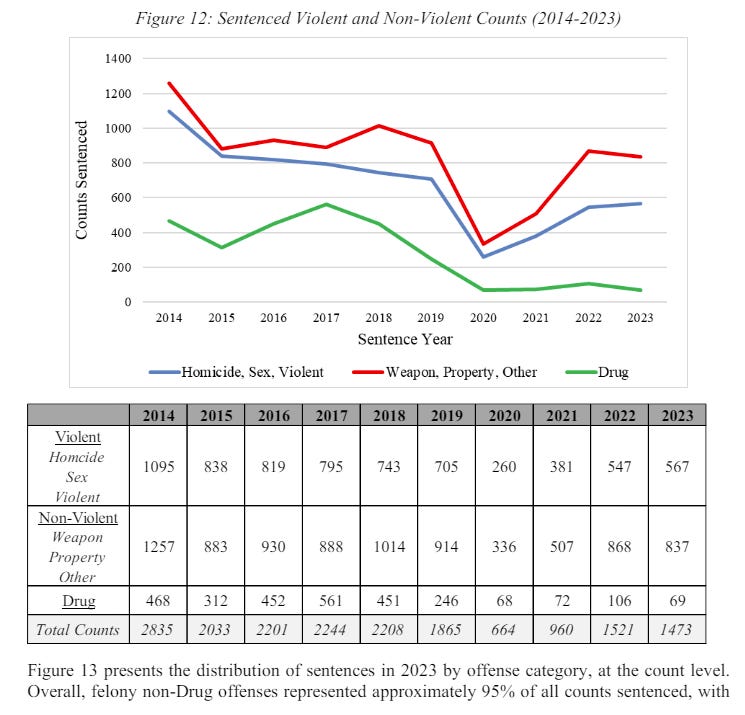
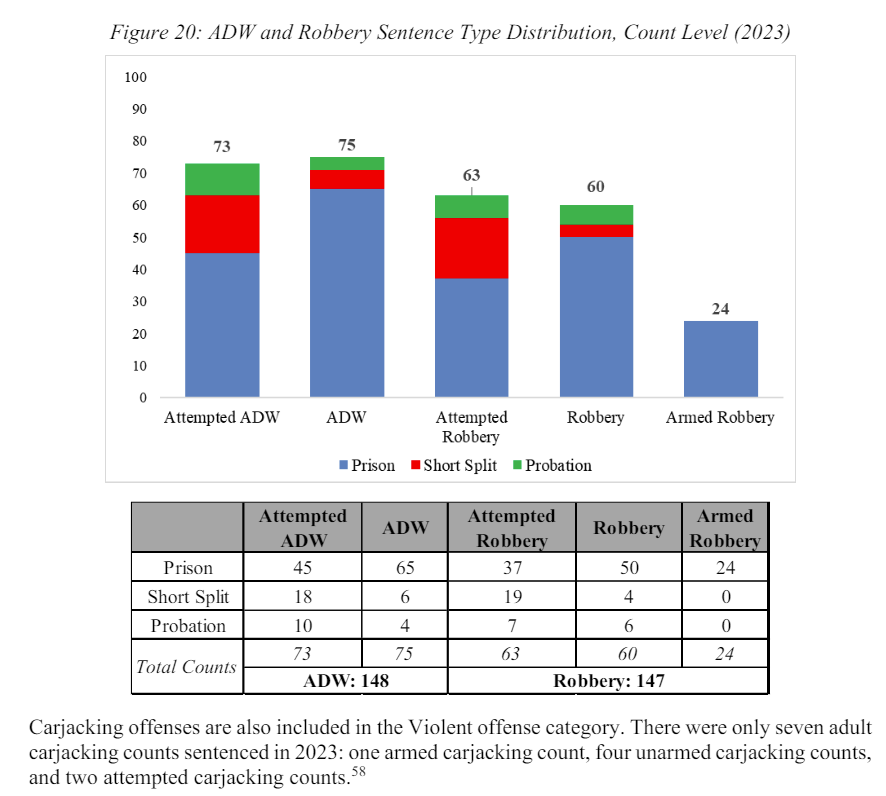
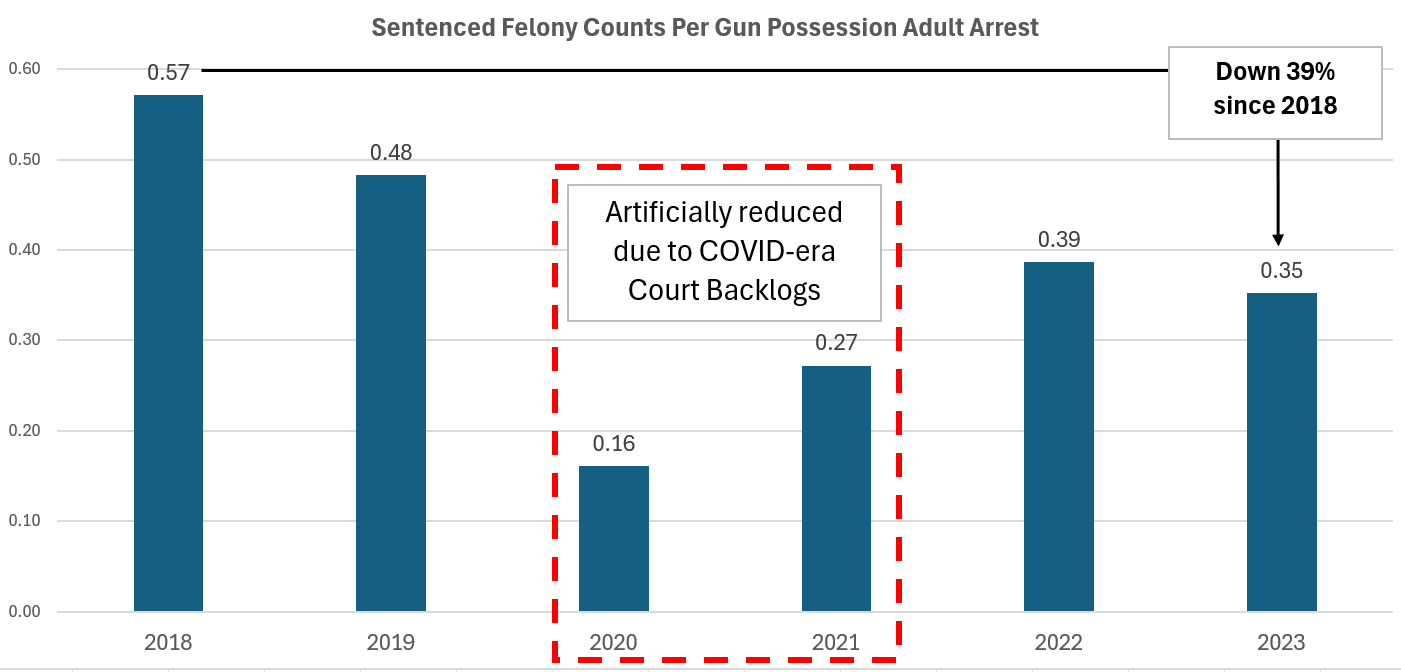





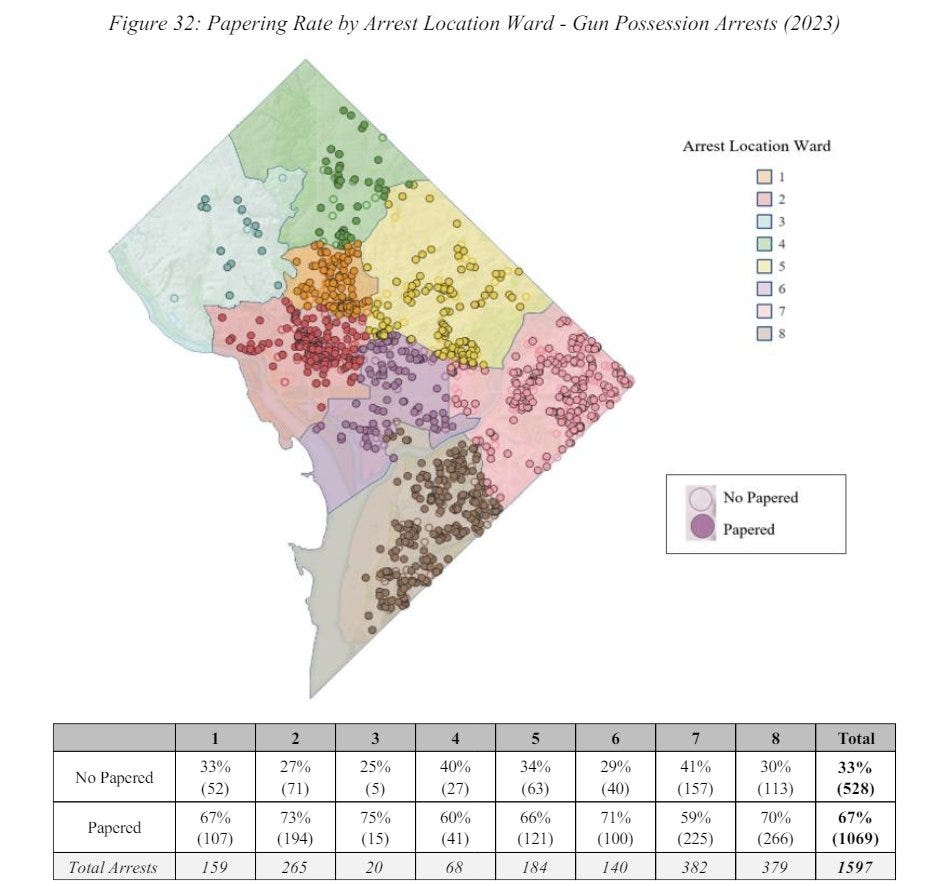
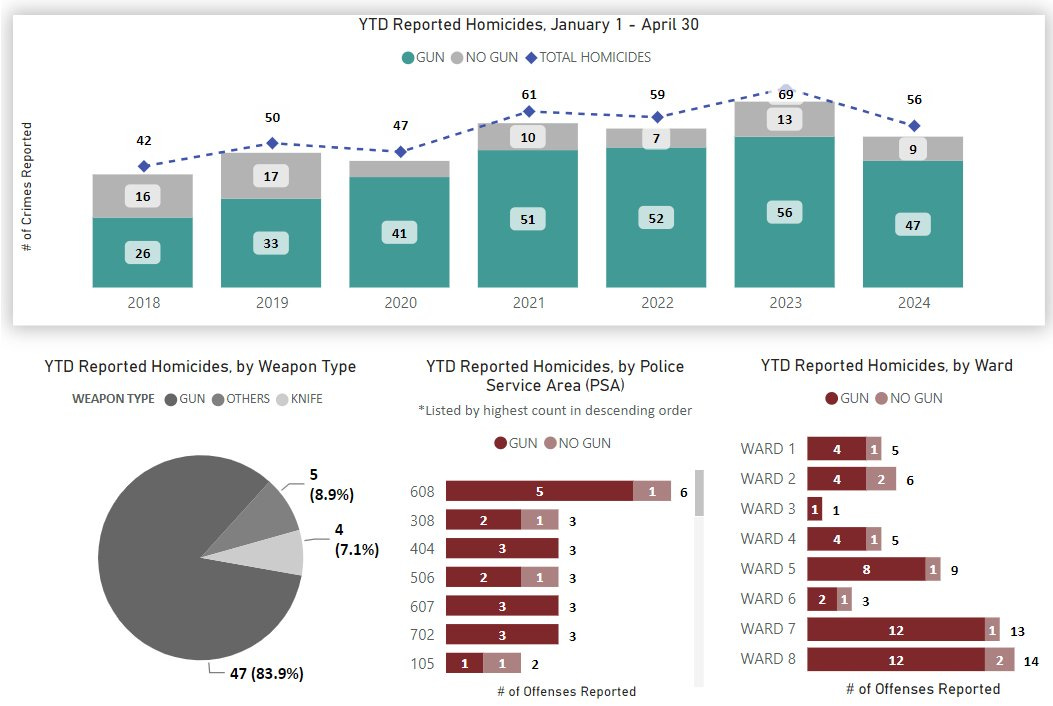



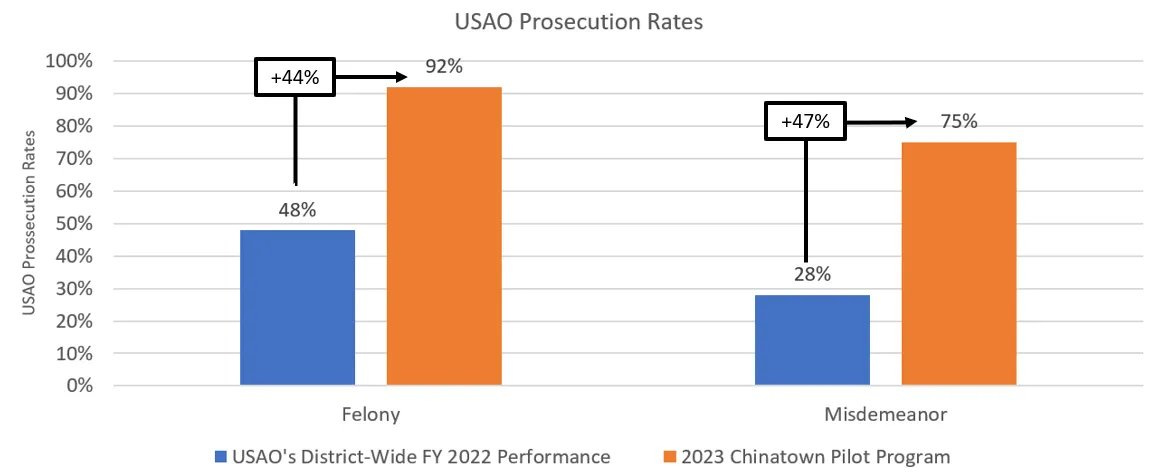
We need to become a state. This is embarrassingly awful.
how about we make it very easy...get caught with using a gun during a car jacking or other violent crime, stop the plea bargaining. Period. Once this happens, you'll see gun crime drop dramatically. If you give a human a chance to break the law again, they will. This is something a kid would know.